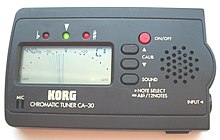Our website is made possible by displaying online advertisements to our visitors.
Please consider supporting us by disabling your ad blocker.
Electronic tuner
This article needs additional citations for verification. (March 2011) |


In music, an electronic tuner is a device that detects and displays the pitch of musical notes played on a musical instrument. "Pitch" is the perceived fundamental frequency of a musical note, which is typically measured in Hertz. Simple tuners indicate—typically with an analog needle or dial, LEDs, or an LCD screen—whether a pitch is lower, higher, or equal to the desired pitch. Since the early 2010s, software applications can turn a smartphone, tablet, or personal computer into a tuner.[1] More complex and expensive tuners indicate pitch more precisely. Tuners vary in size from units that fit in a pocket to 19" rack-mount units. Instrument technicians and piano tuners typically use more expensive, accurate tuners.[2]
The simplest tuners detect and display tuning only for a single pitch—often "A" or "E"—or for a small number of pitches, such as the six used in the standard tuning of a guitar (E,A,D,G,B,E). More complex tuners offer chromatic tuning for all 12 pitches of the equally tempered octave. Some electronic tuners offer additional features, such as pitch calibration, temperament options, the sounding of a desired pitch through an amplifier plus speaker, and adjustable "read-time" settings that affect how long the tuner takes to measure the pitch of the note.
Among the most accurate tuning devices, strobe tuners work differently than regular electronic tuners. They are stroboscopes that flicker a light at the same frequency as the note. The light shines on a wheel that spins at a precise speed. The interaction of the light and regularly-spaced marks on the wheel creates a stroboscopic effect that makes the marks for a particular pitch appear to stand still when the pitch is in tune. These can tune instruments and audio devices more accurately than most non-strobe tuners. However, mechanical strobe units are expensive and delicate, and their moving parts require periodic servicing, so they are used mainly in applications that require higher precision, such as by professional instrument makers and repair experts.
- ^ "insTuner - Chromatic Tuner with Tone Generator 2.5.3". Soft112.
- ^ Piano Tuners Have Built a Bridge To 18th Century. By KATIE HAFNER. New York Times. February 17, 2000. Article describes the use of electronic tuners by piano and harpsichord tuning technicians, including Mr. Callahan's $800 USD CyberTuner software. Available at: https://query.nytimes.com/gst/fullpage.html?res=9500E4DA1331F934A25751C0A9669C8B63&sec=&spon=&pagewanted=2
Previous Page Next Page


